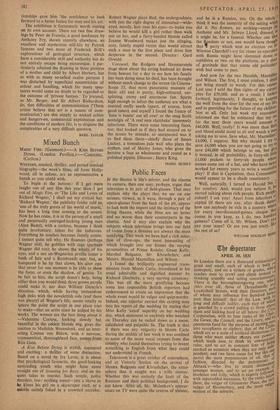Realism and Reality
AT the South-East London Art Gallery, where the words 'The Source of Art is in the Life Q.( a People' are written on the floor in parrInen is an exhibition—'Looking Forward'-0f pictures chosen and introduced by the critic John Berger and called simply 'realist.' M the words social or Socialist are not appended, vlic must presume that some at least do not clualbk)' for the highest honours and indeed the sy°!' presents a considerable variety. There are Peter tures by Jack Smith, Derrick Greaves, t Coker, there are paintings influenced by t"", Italian artist Guttuso, there is quiet `sensitived tonal painting which recalls the Euston Re° d there are journalistic drawings of Indians 0,11, Chinese, there are pictures which, whetec, one is a Marxist or not, deserve to be cane"( formalist. To cover this variety Mr. Bet says that 'there is no such thing as a rets";5 style.' Those who have visited the Beaux AL,' Gallery regularly will not have failed tonotly, that there are certainly realist mannerism' There is also, he says, 'no such thing as re011sy subject matter.' If, as this suggests, all tinegt are real, one cannot help believing that s°11, things are counted to be more real than others Mr. Berger proposes that all these works anPl, connected by a similarity of attitude, a e° to mon belief that 'imagination is the abilitYbIl disclose that which exists,' which presunla means that the painter should concern hilrlsed only with the visible and tangible object,s.di the material world. This is a conviction vielbe has served painters well in the past n. is an obvious example—and will no doubt cio. tinue to do so. But as an exclusive orth°d°f01 a basis of absolute judgement, a reason to believing that only works of this charaecat 'look forward,' it is just a little silly and nerter5 This attitude, supposing all these Plinio would accept their marching orders, does all fortunately exhaust human experience, meatmen are materialists. Mr. Berger tries to s7iti, experiences which are not real to him, the terms 'day dream' and 'private fantasy' i0 figure of Walter Mitty. He bring.,90, William Blake to support one of his argure`..,0 but to Blake the builder of the Pyramidstrwco, real and so were the angels he saw in the . at tops. To Mondriaan, a moralist as fervent' la, Mr. Berger himself, certain immaterial 0'
tionships gave him 'the confidence to look forward to a better future for man and his art.'
The exhibition is fortunately worth visiting on its own account. There arc two fine draw- ings by Peter de Francia, a good landscape by Anthony Fry, shown recently elsewhere, an excellent and mysterious still-life by Patrick Symons and two more of Frederick Brill's explorations of geological structure, which have a considerable skill and authority but do not entirely escape being picturesque. I par- ticularly admired the drawing in three pictures of a mother and child by Albert Herbert, but as with so many so-called realist pictures I was disturbed by superficial eccentricities of colour and handling, which for many spec- tators would come no doubt to be regarded as the outcome of 'private fantasy.' To pretend, as Mr. Berger, and Sir Albert Richardson, do, that difficulties of communication ('These artists believe that art is a means of com- munication') arc due simply to wicked critics and hangers-on, commercial exploitation and the conditions of modern life, is to disguise the complexities of a very difficult question.
BASIL TAYLOR











































 Previous page
Previous page